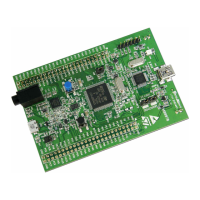The STM32 Cortex-M4 instruction set PM0214
110/262 PM0214 Rev 9
3.6.1 MUL, MLA, and MLS
Multiply, Multiply with Accumulate, and Multiply with Subtract, using 32-bit operands, and
producing a 32-bit result.
Syntax
MUL{S}{cond} {Rd,} Rn, Rm ; Multiply
MLA{cond} Rd, Rn, Rm, Ra ; Multiply with accumulate
MLS{cond} Rd, Rn, Rm, Ra ; Multiply with subtract
Where:
• ‘cond’ is an optional condition code (see Conditional execution on page 65).
• ‘S’ is an optional suffix. If S is specified, the condition code flags are updated on the
result of the operation (see Conditional execution on page 65).
• ‘Rd’ is the destination register. If Rd is omitted, the destination register is Rn.
• ‘Rn’, ‘Rm’ are registers holding the values to be multiplied.
• ‘Ra’ is a register holding the value to be added to or subtracted from.
Operation
The MUL instruction multiplies the values from Rn and Rm, and places the least significant
32 bits of the result in Rd.
The MLA instruction multiplies the values from Rn and Rm, adds the value from Ra, and
places the least significant 32 bits of the result in Rd.
The MLS instruction multiplies the values from Rn and Rm, subtracts the product from the
value from Ra, and places the least significant 32 bits of the result in Rd.
The results do not depend on whether the operands are signed or unsigned.
Restrictions
In these instructions, do not use either SP or PC.
If you use the S suffix with the MUL instruction:
• Rd, Rn, and Rm must all be in the range R0 to R7
• Rd must be the same as Rm
• You must not use the cond suffix
Condition flags
If S is specified, the MUL instruction:
• Updates the N and Z flags according to the result.
• Does not affect the C and V flags.
Examples
MUL R10, R2, R5 ; multiply, R10 = R2 x R5
MLA R10, R2, R1, R5 ; multiply with accumulate, R10 = (R2 x R1) + R5
MULS R0, R2, R2 ; multiply with flag update, R0 = R2 x R2
MULLT R2, R3, R2 ; conditionally multiply, R2 = R3 x R2
MLS R4, R5, R6, R7 ; multiply with subtract, R4 = R7 - (R5 x R6)

